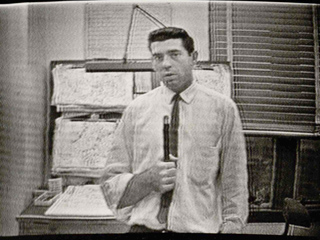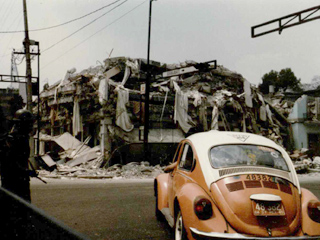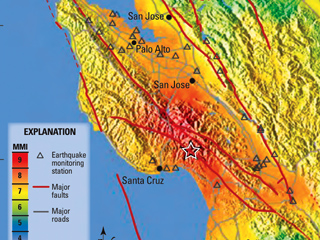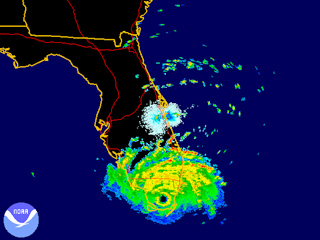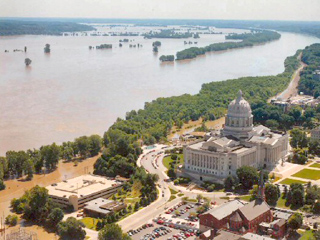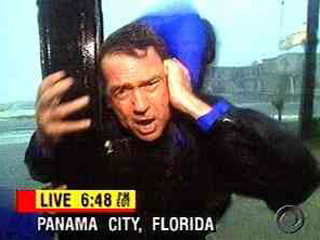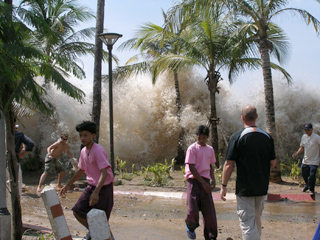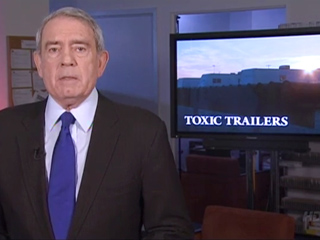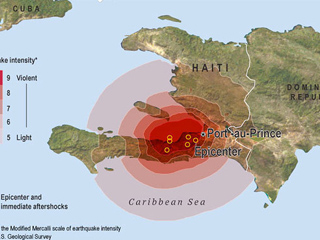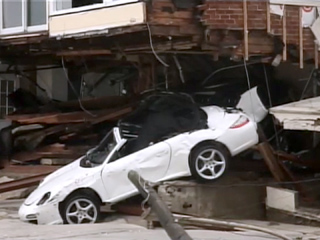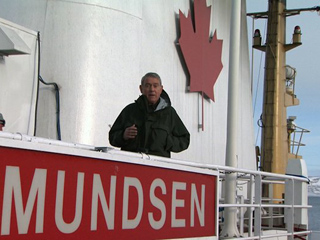Hurricane Carla, 1961
In 1961, Dan Rather was the news director of the CBS affiliate in Houston, Channel 11, KHOU, where he worked with program director Calvin Jones and station manager Jim Richdale. They were following a tropical depression in the Caribbean Sea, which grew to Carla, a Category 5 hurricane. The team decided to go to the Weather Bureau Office in Galveston, which had installed a radarscope, relatively new equipment in 1961. Jones suggested they could maybe put the radar itself on television and once in Galveston, U.S. Weather Bureau Chief of Observation Vaughn Rockney agreed that it would enable them to warn and make people grasp the gravity of the situation. Carla grew 400 miles wide, with the eye 50 miles across, and with 150 mph wind. Jones had the idea to show Carla superimposed on a map of Texas and the Gulf of Mexico, and Rather explained and repeated how dangerous the situation was becoming.
The KHOU team stayed on the air for more than seventy-two hours in what was the first live television broadcast of a hurricane, including the first radar image. But it was not just a television coup, it also saved thousands of lives. A mass evacuation was ordered, and more than 500,000 people left the coast, many convinced by the images they saw on television. While the 1900 Galveston storm had killed six thousand, Hurricane Carla ranks as the most intense U.S. tropical landfall on the Hurricane Severity Index and led to the death of forty-three people. In the Congressional Record, one can read how Texas Senator Ralph Yarborough praised the media, stating that "Rather's accuracy and unstinting efforts were directly responsible for the saving of lives." Rather was awarded both the prestigious Dupont and Ohio State University national awards for journalistic excellence, rarely awarded for local news coverage.
Materials
Mexico City Earthquake
On September 19, 1985, Mexico City was jolted awake by a powerful earthquake of 8.1 magnitude, the strongest to ever hit the area. The epicenter of the quake was actually 250 miles west of the city, in the Pacific Ocean, off the coast of the Mexican state of Michoacán. Between 10,000 and 35,000 people were left dead, 30,000 injured and thousands more homeless as over 100,000 buildings were demolished or suffered serious damage. The Mexican and international communities responded swiftly, wih the United States sending heavy machinery, medical supplies, and excavation equipment. Even First Lady Nancy Reagan toured Mexico City with U.S. Ambassador to Mexico John Gavin.
The destruction created challenges for the networks. Thanks to the work of CBS's Mexico City stringer George Natanson, CBS was the first network to air "unilateral" tape from Mexico City and correspondents on the scene (Juan Vasquez, Martha Tecihner, and David Dow) contributed taped reports. Rather flew immediately to Mexico, and CBS News organized extensive coverage of the aftermath of the earthquake. Talking to the Washington Post, Lane Venardos explained that it was his proudest moment as executive producer: Rather "anchored live on front of a demolished building and on tape interviewed the president of Mexico [Miguel de la Madrid], the U.S. ambassador, and weeping women at a makeshift morgue. He was also seen surveying the devastated city from a helicopter." The Monday CBS Evening News devoted seventeen minutes of its newscast to the earthquake.
Materials
Loma Prieta (San Francisco) Earthquake
On Tuesday October 17, 1989, Northern California experienced a 6.9 magnitude earthquake, whose epicenter was in the Forest of Nisene Marks State Park, ten miles northeast of Santa Cruz on a section of the San Andreas Fault System. Named for the nearby Loma Prieta Peak in the Santa Cruz Mountains, the quake was responsible for sixty-three deaths, close to four thousand injuries, and devastated much of Northern California. The 1989 World Series between the Oakland Athletics and the San Francisco Giants was scheduled to begin as the quake struck at approximately 17: 04 PDT, and It became the first major earthquake in the United States to be broadcast live on national television on ESPN and ABC. Because nearly 62,000 people were at the game at Candlestick Park in San Francisco, rush-hour traffic on the Bay Area freeways was lighter than normal, which may have prevented a larger loss of life.
As Irv Letofsky noted in the Los Angeles Times, people were anxiously searching for information in the aftermath, and local stations emerged as the most helpful. Letofsky praised KPIX and KCBS as well as Rather for his work as he "cautioned us about disaster rumors" and brought in Dr. Chris Scholz, a geology professor, to explain the movement of the quake. Rather and a CBS team flew to California and settled in Oakland. Producer John Reade remembers the technical struggle to have a fully operational evening news in the aftermath of an earthquake, including finding a mobile unit, setting up an uplink to get a signal out, organizing generators for power, and finding a public phone (in a pre-cell phone era) as backup for the audio. Looking back at the coverage of the earthquake, Variety commended the stations for their "dazzling display of technical prowess and ingenuity."
Materials
Hurricane Andrew
What started as a tropical wave off the west coast of Africa turned into a category 5 hurricane, with winds up to 175 miles per hour, once it landed in Florida on August 24, 1992, after hitting the Bahamas. Hurricane Andrew then emerged over the Gulf of Mexico and then moved ashore in Louisiana as a category 3 storm. It then diminished to a depression by August 27 while crossing Mississippi. Warnings of the hurricane led to massive evacuations across Florida, Louisiana, and Texas. Sixty-five people were killed, and the damages exceeded $26.5 billion, making it at that time the costliest hurricane to hit the United States (it is now the fifth costliest).
Advanced planning and the dedication and stamina of their staff enabled local television and radio station to inform the audience, possibly playing a role in limiting the number of casualties. CBS decided to cover the hurricane extensively: Rather was the only evening news anchor to travel to Florida, together with correspondents Bernard Goldberg and Giselle Fernandez, along with Scott Pelley in New Orleans. The CBS team did 48 Hours Special edition about Andrew and Harry Smith reported from the disaster zone for CBS This Morning. The work paid off, as CBS Evening News got a 33 percent spike in the Nielsen ratings, putting the broadcast in first place for the first time in three years, and 48 Hours got a 17/30, tops among all prime time shows.
Materials
The Great Mississippi and Missouri Rivers Flood of 1993
Lasting from April to October, the 1993 Midwest flood was one of the most significant and damaging natural disasters ever to hit the United States. Damages totaled $15 billion, fifty people died, hundreds of levees failed, and thousands of people were evacuated, some for months, and nine states were affected over 400,000 square miles. The size of the flooded area, the duration of the flood, the number of persons displaced, and the crop and property damage, as well as the magnitude of the crests and the number of record crests, made it the worst such U.S. disaster since the Great Mississippi Flood of 1927.
Upon hearing of the disaster, Rather flew back from his assignment in China to St. Louis, Missouri, in July. With producer Wayne Nelson, he set up to get viewers an overview of the situation from an helicopter and then took us inside the flooded home of the mayor of La Grange. Rather anchored 48 Hours in Des Moines, which was under siege with inhabitants frantically sandbagging the levee, and he talked briefly to President Clinton, who toured the Midwest. At the end of July, Rather reported from West Quincy, Missouri, the town which had lost its fight against the ever-rising river and was now a lake.
Materials
Hurricane Opal
Originating in Guatemala, Hurricane Opal crossed the Yucatan Peninsula before blowing ashore the Florida Panhandle on October 4, 1995, as a category 4 hurricane with wind gusts up to 144 mph and a 15-ft storm surge. One of the worst hurricanes to hit the Gulf Coast since Hurricane Camille in 1969, Opal destroyed or damaged thousands of homes and businesses as it barreled its way through Florida, Alabama, Georgia, and the Carolinas. It was downgraded to a tropical storm over Tennessee, turned into a tropical depression over Ohio, and finally broke apart in Ontario, Canada. Sixty-three people died in storm related-events, and the damages exceeded $5.1. billion.
Rather, Harry Smith of CBS This Morning, and a dozen CBS technicians, including producer Michael Fountain, cameraman Mike Hernandez, and sound man Paul Sedia, reported from Panama City, Florida, as the storm made landfall. Rather set a new television precedent by reporting from "the eye of the storm" with one arm wrapped around a pole in the midst of the 140 mph hurricane and they could see the sea surge, while Michael Fountain was holding him by his legs.
Materials
Indian Ocean Earthquake and Tsunami
On December 26, 2004, a 9.1 magnitude earthquake shook Southeast Asia, off the West Coast of Sumatra, Indonesia. According to United States Geological Survey scientists, the sea floor near the earthquake was uplifted several meters. The displacement of water above the sea floor triggered the tsunami, which caused catastrophic levels of destruction in countries around the Indian Ocean basin, reaching as far as the east coast of Africa. Combined, the earthquake and tsunami killed 230,000 people in fourteen countries. Indonesia was the hardest-hit country, followed by Sri Lanka, India, and Thailand.
As producer Christopher Martin remembers, the news cycle was in a sort of hibernation between Christmas and New Years, and news about the disaster trickled slowly to the United States. Rather, however, was determined to go to Indonesia, sensing a big story. As the News Division was reluctant to send him there (and pay for it), Josh Howard and 60 Minutes II decided to do it. Within a few days, a small team made of Rather and producers Martin and Elliot Kirschner were on board of the USS Abraham Lincoln Carrier Group. What they saw was complete destruction, as Martin put it, "it was like the sea came in and just ripped five miles of humanity off into the sea." In the following days, they documented the humanitarian efforts and interviewed aid workers and soldiers, including the three-star Marine Corps General Robert "Rusty" Blackman, who was quite moved by his experience.
The logistics were altogether difficult, and the 60 Minutes II team would have had a hard time without the help of the navy, especially when some of the recorded tapes got lost for a little while. Despite the tragic story, Rather still found a moment, at 3 am, to be thankful for being able to pursue his journalistic passion. Talking about his work in Southeast Asia, Rather told the New York Times: "There is no place I'd want to be. . . . I literally say a prayer of thanks every day in order to have this work. A story like this is why you get in the business."
Materials
Hurricane Katrina
On August 29, 2005, Hurricane Katrina struck the Gulf Coast as a category 3 storm with sustained winds of 100–140 miles per hour. Levee breaches led to massive flooding, and hundreds of thousands of people in Louisiana, Mississippi, and Alabama were displaced from their homes. By far the costliest hurricane to ever strike the United States, with at least $108 billion of property damage, Katrina was directly responsible for about 1,200 deaths, and it remains the third deadliest hurricane to strike the United States. As it stretched some four hundred miles across, the storm did a great deal of damage, but its aftermath was catastrophic, especially in New Orleans.
In New Orleans, the storm surge of up to twenty feet overwhelmed the city's levees and drainage canals and three levees broke, putting nearly 80 percent of the city under water. Although 80 percent of the city's population evacuated, some ten thousand sought shelter in the Superdome, which quickly became the epicenter of the calamity that was the aftermath of Hurricane Katrina. Without power or running water, desperate New Orleanians ran out of water, food, and shelter and the most vulnerable, the old, young, and sick, were left to die. The federal government was slow to respond, from FEMA, which took days to establish operations in New Orleans, to President Bush, who seemed unaware of the gravity of the situation, sending the National Guard and SWAT teams instead of water. Race and class prejudices led to exaggerated, and later rebutted, reports of extensive looting, violence, and sexual assaults. The city suffered economically, but the impact of Katrina was felt most strongly in the African American community, which decreased from 66 to 59 percent of the New Orleans population, and struggled with the loss of its community.
A few days after Katrina drowned New Orleans, a team of veteran CBS News correspondents covered the deadly destruction and extraordinary misery caused by the hurricane. John Robert and Lee Cowan reported on the sense of hopelessness among of people stranded in the city, desperately waiting for help that came too late for too many. Rather interviewed Dr. Frederick Cerise, head of the Louisiana Department of Health and Hospitals, about the threat of widespread disease, and Harry Smith traveled along the destroyed Gulf Coast. Rather continued to follow up on the story after leaving CBS. With Dan Rather Reports, he investigated the lasting impact of Katrina on the Gulf Coast, who was getting the clean-up contracts, where the Katrina debris went, and the difficult economic recovery of the city. He looked at how FEMA trailers were making people sick, staying with the story as it continued to develop, and asked why people where still living in trailers. He followed up four years later to find that things were not better, and reported in 2010 on the disappearing Louisiana coastline.
Materials
Haiti Earthquake
On January 12, 2010, an earthquake of magnitude 7.0 struck Haiti and the Dominican Republic, followed by about fifty aftershocks. Death toll estimates range from 100,000 to 200,000, with hundreds of thousands of survivors displaced. Some three million people were affected by the quake. Thousands of building collapsed, most due to Haiti's lack of building codes. Already beset by a strained and inadequate infrastructure and still recovering from the two tropical storms and two hurricanes of August–September 2008, the country was ill-equipped to deal with such a disaster.
The Dan Rather Reports team made its way to Haiti, determined to show what life was like for the survivors of Haiti's earthquake, long after the dignitaries departed and the media circus moved on. In Port-au-Prince, they talked to international aid workers and doctors coming from Salvador or Brazil, to workers trying to clear the debris, to refugees living in tents, and to injured children, trying to find normalcy. Rather also surveyed the damage with three-star Lieutenant General P. K. Keen, in charge of the relief effort, from a navy Seahawk helicopter. He talked to a team of geologists who came to help the rebuilding efforts in Haiti and concluded that much of Port-au-Prince may never be safe from future earthquakes.
As producer Dana Roberson remembers, the goal was not to compete with the twenty-four-hour news cycle, but to focus on the aftermath of the earthquake and the fate of the people there. They worked with a group of independent pilots who were flying back and forth to bring food to the refugees. She noted how Rather was full of energy in such a situation, "when it comes to real stories like that, he is on fire." The story "Aftershock" was nominated for an Emmy in 20011 in the category "Outstanding editing—quick turnaround" for the work of the editors Steve Tyler and Nels Bangerter.
Materials
Gulf Oil Spill
The Deepwater Horizon Oil Spill, or BP Oil Spill, started on April 20, 2010, with the explosion and sinking of the Deepwater Horizon oil rig, which killed eleven workers and injured seventeen. As a result, a sea-floor oil gusher flowed for eighty-seven days until it was finally capped on July 15, 2010. Up to 60,000 barrels of oil escaped per day for a total of 4,900,000 barrels of oil, or 170 millions gallons of crude oil. The largest marine oil spill in history polluted 1,100 mile of shoreline in Louisiana, Mississippi, Alabama, and Florida. Cleanup efforts were costly and difficult, especially in the marshes and estuaries with their delicate plant life. Thousands, working in the fish, tourism, and oil industries lost their livelihoods, and BP spent over $40 billion in cleanup and recovery. A report released by the Joint Investigation Team of the Bureau of Ocean Energy Management, Regulation and Enforcement (BOEMRE) and the U.S. Coast Guard emphasized BP’s ultimate responsibility for the disaster. Civil and criminal investigations followed against BP, Transocean, Anadarko, and Halliburton, and fees and additional penalties reaching billions were paid.
The Dan Rather Reports team flew to the Gulf Coast in June as the oil was still gushing. Their first step was to talk to scientists who were trying to understand the effects of this massive uncontrolled undersea experiments. As BP and the government tried to keep the oil off the marshland with hundreds of miles of boom deployed to cordon off the shore, the use of chemicals called "dispersants" was highly controversial, as their effects in the open ocean remained unknown. A subsequent report in September investigated the conflicting claims about where all the oil went. A group of scientists found thick layers of sedimented oil on the sea floor and documented the death of plankton, pteropods, which play an essential role in the food chain. On the one-year anniversary of the spill, Rather talked to Kenneth Feinberg, the man in charge of handing out the $20 billion fund BP set up to compensate the victims.
Materials
Hurricane and Superstorm Sandy
A late-season post-tropical cyclone, Sandy swept through the the central Caribbean on October 22, 2012, and intensified into a category 3 hurricane as it tracked north across Jamaica, eastern Cuba, and the Bahamas. Sandy moved northeast of the United States until turning west toward the mid-Atlantic coast on October 28. While it transitioned into category 2 storm off the coast of the northeastern United States, Sandy became the largest Atlantic hurricane on record (as measured by diameter, with winds spanning 1,100 miles). The full moon amplified the storm surge, and Sandy's kinetic energy for storm surge and wave destruction potential reached a 5.8 out of 6 on the National Oceanic and Atmospheric Administration’s scale. Sandy caused close to $75 billion in damage in the United States and at least $315 million in the Caribbean.The total death toll reached 233, with thousands homeless and millions without power.
The Dan Rather Reports team looked at this loss of power, which affected close to eight million people at its peak, and why it took so long to repair. They investigated one power company in New Jersey that had come under heavy criticism and found out that an era of deregulation might have left power companies and regulators across the country more focused on cutting costs and maximizing profits than keeping the lights on.
Materials
Miscellaneous Environmental Stories
In addition to reporting on natural disasters, Dan Rather has done numerous stories about environmental issuers. These range from talking to environmentalist actor Robert Redford as he battled the Utah's Southern Edison Company in 1976 to interviewing the director of the California Air Resources Board (CARB) Mary Nichols in 2007. "Treasure Island," for example, investigated the impact of logging in the island of Madagascar, while "Pollution in Paradise" examined the rapidly changing environment in the Galapagos Islands and how the islands are threatened due in part to a flood of tourists. Rather also followed scientists' quest to find out why bees are dying.
By their very nature, many of these stories discussed the issue of global warming and its effect. The Dan Rather Reports team went to Greenland in 2007 to talk to scientists who reported that the ice was melting much more rapidly than they anticipated and to Iceland in 2010 to look at the effect of the ash spewed by the Icelandic volcano Eyjafjallajökull. Rather reported from 450 miles north of the Arctic Circle where the warming sea ice is rapidly receding, possibly opening up the elusive northwest passage so many European and American adventurers were looking for. He looked at a similar development in Glacier National Park in Montana, where the number of glaciers shrunk from 150 to 25. In a story entitled "The Science Behind the Storms," Rather explored how computer modeling has made tracking hurricanes more precise and asked if global warming affected hurricane intensity.


